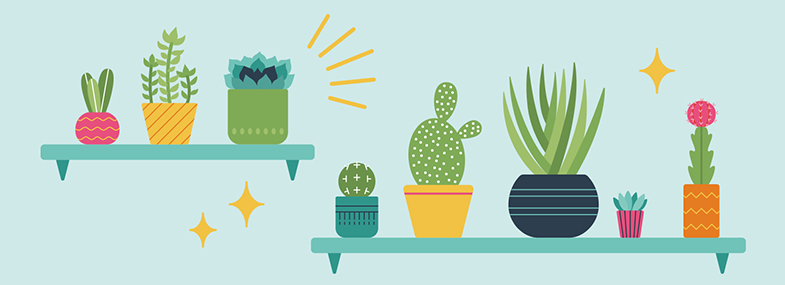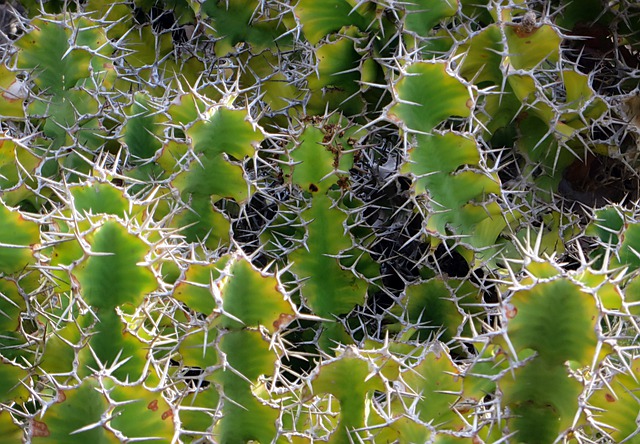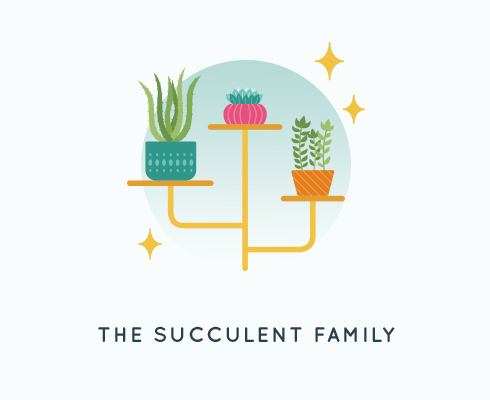The Definitive Guide to Cacti & Succulents for beginners

Succulents and cacti are among the most popular plants for a good reason. They are versatile, easy-to-care-for, come in many different colours, shapes, and sizes and they make perfect additions to any plant collection. Their unusual textures and their surprisingly beautiful blooms have made them an all-time favourite for novice and experienced gardeners alike.
If you already have a few succulents and cacti, then you know that there’s always room for one more. And we couldn’t agree more. Therefore, we’ve decided to create this cacti and succulents guide and we promise it’ll be an interesting read. So whether you’ve just purchased your first tiny cactus or you already have an impressive collection of succulent plants, keep on reading.
Throughout this article we’ll cover the basics of cultivating cacti and succulents, we’ll explore their features and particularities, and we will offer valuable resources such as books, clubs, and useful websites. So without further ado, let’s start our journey into the fascinating world of succulents and cacti.
Table of Contents
Chapter 1: Cacti & Succulents 101

Although cacti and succulents are found pretty much everywhere on the planet and they’ve adapted to all types of habitat, most of them are native to arid or semi-arid regions. Their ‘superpower’ consists of being able to withstand dry, desert-like conditions that no other plants can tolerate. How they do it? They accumulate water in their leaves, stems, and roots, which are made of a special type of water-storing tissue that gives these plants their succulent aspect.
But not all succulents are native to hot environments; some have evolved in the cold, mountainous regions of Europe, where their sturdy succulent bodies enabled them to grow in nutrient-poor, rocky soil. Thanks to their small size and their robust shape, they can also withstand strong winds. Other succulents grow natively in the jungles of South and Central America or on beaches where the salty air made life difficult for other plants.
Cacti grow natively on the American continent. The oldest cactus fossil dates back to 50 million years ago and it was found in Utah. Most cacti grow in the desert, but some grow in surprising places such as the tropical Caribbean islands where you’ll find tall columnar cacti growing happily among exotic large-leaved trees and hanging vines.
What Is the Difference Between Succulents and Cacti?

A very important thing to remember is that all cacti are succulents but not all succulents are cacti. Succulents are a broad group of plants that include 50-60 botanical families such as Agavaceae, Aloaceae, and Cactaceae or Agave plants, Aloe plants, and Cactus plants.
These plants are closely related to cacti being a sub-category of succulents and all, so you don’t have to feel bad for not having a hard time telling them apart in some cases. To make things a bit easier, let’s take a look at a few major differences between cacti and succulents:
- Cactus plants don’t have leaves.
- Cactus plants have round, cushion-like lumps, also known as areoles from which spines, hairs, and flowers grow. The areoles can look fluffy or quite scary and painful to touch.
- Some succulents can have spine-like growths (see Aloe Vera and Agave), but they never have areoles. So, the areoles are the key to telling them apart.
- Non-cactus succulents can be found on all continents but the members of the Cactaceae family are native to the New World.
Brief History of Succulents and Cacti

Let’s begin with a surprising fact – the oldest surviving image we have of a succulent plant dates back to the rule of Thutmose the 3rd, an Egyptian pharaoh, who lived between 1481 and 1425 BC. Thut the 3rd was quite passionate about invading Syria and about collecting exotic things like animals, plants, and luxury goods, all illustrated in a series of wall drawings in a temple Karnak.
The only distinguishable succulent was a Kalanchoe citrina, but there were many others that the explorers couldn’t pinpoint. This discovery gave birth to the idea that Karnak was the first Botanical garden in the world and the gardener in charge was an Egyptian gentleman called Nekht. But although the first illustration of a succulent is just a few thousand years old, carbon dating shows that the oldest species of succulents called our planet home 24,000 years ago.
We’re going to skip a few thousand years of succulent history (mainly because for a long time, our bulbous friends were overshadowed by roses, carnations, and tulips) and talk about more recent events. The current popularity that succulents are enjoying is owed to a terrible drought that affected Californian gardeners back in 2011. The plants that were populating people’s gardens back then proved too difficult to care for without rain, so people had to find an alternative – low maintenance plants that can withstand long periods of drought: SUCCULENTS!
At the same time, more and more people were drawn to gardening and this relaxing and fulfilling activity quickly became a worldwide trend. The younger generations were learning to love nature. But they faced two major issues: lack of space and lack of money. So how can this generation of gardening enthusiasts have their garden? By getting a few succulents and cacti. And the experience wouldn’t be complete if these succulents and cacti didn’t have their own Instagram page.
It is safe to say that the latest technological and horticultural advancements, global warming, busy schedules, and smaller houses made succulents and cacti the unlikely superstars of modern-day gardening. In 2020, succulents and cacti are bested only by cat videos. These bloaty plants are now the #1 choice of landscapers and designers, so you shouldn’t be surprised to see them in bridal bouquets, in Airbnbs, at your friend’s house, in your favorite restaurant, or on Reese Witherspoon’s front porch. If you don’t believe us, just type #cactuslover or #succulentsofInstagram next time you upload a photo of your cat sleeping in a cute position.
The Many Uses of Succulents and Cacti
These versatile plants have been used in many different ways throughout history: as a food source, to make dye, as herbal remedies, and even as weapons. Their unique appearance and the fact that they were easy to preserve on long journeys have made them worthy companions. Let’s take a look at few notable uses that succulents and cacti had over the years:
- Many succulents such as Aloe Vera plants have been used in various cultures as traditional medicine. There are many references for using succulents as remedies in Chinese, Japanese, Mexican, Egyptian, Indian, and Greek cultures especially for digestive problems, wound healing, vitamin deficiency, etc. Saguaro cacti, for instance, were used to create splints for broken bones.
- For centuries, succulents and cacti have been a valued food source rich in vitamins and nutrients. Saguaro cacti, Opuntia cacti, Stronecrop sedums, Aloe Vera, Salicornia, and Barrel cacti are just a few examples of succulent plants that can be consumed either raw or cooked. Cacti and their fruits are valued in Mexican cuisine and they are often used in salads, as a filling, to make desserts, and juice.
- People also use cacti as fences to protect their properties from animals and intruders. Echinocactus grusonii, Ferocactus emoryi, and Opuntia acanthocarpa were and still are often used as protective barriers.
- Other uses: as musical instruments, to make dye, as animal traps, to build houses, to make tools, arrows, and other weapons.
- The Aztecs used Barrel cacti for religious sacrifices, while the Peyote and the San Pedro cacti were used by indigenous people in many rituals due to their psychoactive properties.
- Succulents and cacti remove toxins and help keep the air fresh, so they are used as natural air purifiers by many gardeners.
- They improve the humidity levels, so growing succulents and cacti can help people prevent a sore throat, dry skin, and common colds.
Chapter 2: Cultivating Cacti & Succulents

When caring for a succulent, be it a smooth or a thorny one, it’s very important to take its native environment into account. Succulents and cacti that are native to arid regions will do fine with very little water and plenty of sunlight, while those who grow natively in lush jungles or mountainous regions will require a higher level of humidity and plenty of shade.
But let’s take a closer look at what our beloved succulents and cacti need in terms of light, temperature, water, and soil and how to propagate and protect them from pests and diseases.
Temperature
Most succulents and cacti will grow happy and healthy in temperatures between 40-80°F (4°C- 27°C). Minor temperature variations are usually tolerable, but frost and extreme heat can cause serious damage.
During the cold winter months, it’s best to keep your succulents and cacti indoors to protect them from frost damage. Some varieties of succulents (such as Sempervivums and Stonecrop sedums) are more frost-tolerant than others and can survive temperatures as low as -1°C (30°F). Tropical succulents (such as Agave, Aloe, Crassula Arborescens, Blue Senecio, Euphorbia tirucali, and pretty much all cacti) are heat-enduring but won’t survive frost. So, the key here is knowing what type of succulent you’re growing and adapting the temperatures accordingly.
Interestingly enough, a lot of succulents and cacti will do best in temperatures that are near the aforementioned limit. So, if you want to ‘force’ your plants to produce flowers or to change colour, try keeping them at temperatures of 5°C-8°C (40°F-45°F) or 24°C -27°C (75°F -80°F).
Light
In terms of sunlight exposure, most succulents and cacti will require plenty of light. So, when you’re growing them indoors, it’s best to place them in a bright place such as a North-facing windowsill (unless you’re in the Northern Hemisphere, then South is better)
But! Most succulents will get sunburnt if they spend too much time in direct sunlight, so make sure you protect them from the harsh afternoon sun. Being used to desert-like conditions, cacti are more tolerant of sunlight and they won’t need as much shade as their smooth relatives.
The light conditions should match the type of succulents or cacti that you’re growing. Forest-growing succulents like Rhipsalis, Senecio, or Schlumbergera will thrive in semi-shade, but Echeverias, Cotyledons, and Graptopetalum need bright light.
Water
The watering needs of succulents and cacti are very different from those of other plants. A lot of novice gardeners will try to water their succulents just like they water other houseplants. That is a very common mistake that often results in irreversible damage.
The safest way to water your succulents and cacti is by using the ‘soak and dry’ technique. How does that work? All you have to do is to soak the soil completely and then patiently wait for it to dry before repeating the process. It’s very important to ensure that your containers have drainage holes that allow water to drain properly. To see if the soil is dry, check it with your finger.
Most indoor succulents are quite sensitive to humidity, so it’s best to ensure that their leaves don’t get wet. This is not such a big problem outdoors, because the airflow, the sun, and the wind will quickly evaporate the water.
Wet feet are the biggest enemies of succulents and cacti which will develop root rot if they sit in wet soil for more than 2-3 consecutive days.
So how often should you water your succulents? Unfortunately, there is no exact answer. It all depends on the environment. For many indoor succulents and cacti growers, watering once every 14-21 days seems like a good frequency.
To find the best watering schedule for your succulents and cacti, you need to consider their natural habitat, the current environment, their soil, and whether they are currently growing or dormant. Succulents and cacti that are dormant prefer to be left alone and they will need less water than they do during their growing season.
Soil
This is the easy part. All succulents and cacti require well-draining soil. You can opt for a store-bought succulent and soil mix, or you can make your combination using just three ingredients: two parts regular gardening soil, two parts sand (coarse sand works better than fine sand), and one part pumice or perlite.
The goal here is to obtain an airy soil that will allow water to drain quickly while also preserving a little moisture.
When choosing the soil for your succulents and cacti, try to avoid peat. You will often find peat in commercial mixes and although it is quite useful at first as it retains the optimal amount of moisture, over time it becomes less absorbent, and your plants won’t be able to absorb any water.
Important Tip: Always change the soil for a newly bought succulent or cactus. Most succulents and cacti are sold in low-quality containers that are too small and with improper soil.
Fertiliser
You can fertilise your succulents and cacti if you want to encourage growth and to ensure that they grow harmoniously. Although succulents and cacti are awesome as they can survive some of the harshest environments on planet Earth, they don’t mind being spoiled and pampered once in a while. So, you can fertilize them once or twice a year, during their active growth period (usually during the warm seasons), with light fertiliser.
You can choose one that’s specifically marketed for succulents and cacti, or try a cheaper alternative such as earthworms, manure tea, or Epsom salt. Whatever you choose, make sure you check the instructions and do some research on the needs of your plant.
Propagation
You can propagate succulents and cacti through division, cuttings, and seeds. Most growers will choose the first two options, as the seeds can be quite difficult to obtain.
Propagating a plant through division consists of removing the plant from its container, and dividing its roots and stems into two or more sections. Succulents and cacti often produce offsets which can easily be separated from the mother plant and moved to a separate container.
Another great option is propagating your succulents through cuttings. Many succulents can easily be multiplied just by cutting a small piece of stem or a succulent leaf and waiting for it to develop its root system. This is a very productive way to obtain many new plants at once.
Seeds are also effective, but they are the most time-consuming option. Additionally, not all succulents and cacti get to produce seeds, especially when grown in a container.
Pests and Diseases
You don’t have to worry about pests and diseases too much when growing succulents and cacti. The most common issue associated with these low-maintenance plants results from overwatering and consists of fungal diseases and bacterial infections.
Occasionally, other pests such as root mealy bugs, scale, and spider mites might be attracted to your beloved succulents. When that happens, take action as soon as possible by quarantining the affected plants, removing the pests with a stream of water or with a cotton swab dipped in alcohol, and use an insecticidal soap or Neem oil.
Useful Tools
You don’t need a lot of tools when growing succulents and cacti, since these adorable plants are generally small. If you want to be more professional, you can put together a gardening toolbox that contains tweezers, brushes, pruning shears, cactus saws, measuring cups, spray bottles, a moisture meter, a hand trowel, gardening gloves (especially useful if you’re growing cacti).
You can also find a wide range of ready-made succulent and cacti tool kits without much effort.
If you’re handing large cacti, things can get a bit more complicated and you might need heavy-duty welding gloves.
Chapter 3: The Cacti Family

As mentioned above, all cacti are succulents that belong to the Cactaceae plant family, which consists of 131 genera and 1866 known species. The Cactaceae family is quite fascinating as it introduces us to the universe of spiny stems and brightly-colored flowers.
From tiny and adorable to gigantic and ferocious, cacti come in all shapes and sizes, but all of them are native to the Americas. They are all perfectly adapted to arid environments, but some of them grow natively in tropical and subtropical areas. They don’t really have leaves. Instead, they have succulent stems, spines, hairs, and showy flowers.
Now that you know what cacti are, let’s take a look at some of the most popular types.
Opuntia

Opuntia is a large genus that consists of 150-180 different species of cacti. Opuntia cacti are flat-jointed, with paddle-like stem segments (also known as cladodes), glochids, and small bristles. Their beautiful flowers are usually pink, orange, or yellow and the fruit is red, green, or yellow and edible. They can be found all over the American continent where they are often referred to as Prickly Pear.
Carnegiea Gigantea

Commonly referred to as Saguaro cacti, the plants that belong to the Carnegiea Gigantea are large and grow abundantly in Arizona, California, and Mexico. These friendly giants have had many different uses over the years. They’ve been an important source of nutritious food for American Indians, who also used them as a building material, to make weapons, to store food and water, etc. Saguaro cacti are ribbed and columnar and they grow up to 40 feet (12 m) tall.
Ferocactus

Ferocactus, also nicknamed ‘The Barrel Cactus’ is a bit of a stereotype for the entire cactus family. With its unique rounded shape, the Barrel cactus has appeared in hundreds of paintings, cartoons, and other forms of art. Ferocactus grows natively in Mexico and the Southwestern United States and they are quite sought-after by gardeners and cacti enthusiasts. It is worth mentioning that all Ferocactus cacti are considered Barrel Cacti, and so are their spiny fellas that belong to the Echinocactus, Astrophytum, Echynopsis, Sclerocactus, Neolloydia, and Thelocactus genii.
Gymnocalycium

Also known as the Chin cactus, Gymnocalycium is a genus that consists of 50 fascinating species of cacti. Native to Brazil, Bolivia, Argentina, Paraguay, Uruguay, and other South American countries, these cacti are usually cultivated as houseplants. They are small, cylindrical, ribbed, and produce beautiful flowers that can be cream, pink, red, or yellow. The most interesting Chin cactus is Gymnocalycium mihanovichii, commonly referred to as the moon cactus.
Epiphyllum

Native to Central America, Epiphyllum cacti are epiphytic plants (air plants) that have a natural tendency to grow upon other plants or objects. Contrary to popular belief, epiphytes are not parasites, they merely require physical support because they are not attached to the ground. Leaf cacti, climbing cacti, and orchid cacti all belong to the Epiphyllum genus. They have broad and flat stems, lobed edges, and large flowers with many petals.
Chapter 4: The Succulent Family

We’ve already covered the basics of what succulents are and what they need to grow healthy and happy. So, in this chapter, we’ll focus on discussing a few of the most common succulent families except for the Cactaceae family. In other words, we’ll get you acquainted with a few succulent plants that have a smooth surface and that lack glochids (areoles that have prickles and hair-like spines).
Agavaceae

Commonly referred to as the Agave subfamily, these succulents can come in many different shapes and sizes. This group of plants contains Agave, Yucca, and Joshua tree, and in some cases, also Dracaenaceae plants. The plants that belong to the Agavaceae family are quite important from an economical point of view as they have been used in folk medicine, to produce soap, baskets, hats, foods, and drinks. The succulent leaves of the Agavaceae succulents grow in rosettes on a woody stem and can have spines along their margins.
Aizoaceae

This is an extensive family of flowering plants that grow natively in Southern Africa, Australia, and the Pacific area. The succulents that belong to the Aizoaceae family are often referred to as stone plants, mesembs, or ice plants. Pleiospilos, Lithops, and Marlothistella are highly appreciated by gardeners and succulent growers.
Aloaceae

The Aloaceae family of succulents is probably the most popular one as it contains Aloe and Haworthia plants. Every succulent lover has at least one Aloe plant, so it’s pretty much impossible not to be familiar with them. Native to Madagascar, Africa, and the Arabian Peninsula, Aloe plants can now be found all over the world. They make perfect houseplants and they have many uses in medicine and the beauty industry.
Crassulaceae

Also known as stonecrop succulents, the plants that belong to the Crassulaceae family are herbaceous and shrub-like, but some can be aquatic or treelike. They are perennials and very popular as garden plants or indoor houseplants as they are quite easy-to-care-for. The most popular succulents of the Crassulaceae family are Crassula Ovata, Sempervivum, Kalanchoe, Echeveria, and Cotyledon. They come in many different shapes, colors, and sizes, so if you have a favorite succulent, it probably belongs to the Crassulaceae family.
Euphorbiaceae

The Euphorbiaceae family of succulents commonly referred to as Euphorbias are beautiful flowering plants that grow natively in tropical regions of the American continent, Africa, and in non-tropical regions such as South Africa, the Middle East, the Mediterranean basin, and the Southern United States. Euphorbia plants are highly appreciated as houseplants and the most popular ones are Euphorbia milii (Crown of Thorns), Euphorbia obesa (Basketball Euphorbia), and Euphorbia marginata (Snow-on –the-Mountain).
Chapter 5: Designing with Cacti & Succulents

Cacti and succulents have become amazingly popular over the past few years and we’re not surprised. They are easy-to-care-for, come in a wide range of colors, shapes, and sizes, and they produce beautiful flowers (if they don’t, their leaves will make up for it). As a result, they are highly appreciated by interior designers and landscapers and the good news is, you don’t have to be an expert to design with cacti and succulents. All you need is a little bit of free time, patience, and lots of love for these friendly plants.
Growing Cacti and Succulents Indoors

Cacti and succulents don’t just look great, they can also make you more productive, sharpen your focus, purify the air in your home, and keep the humidity levels balanced. They are a great way to add a bit of color and texture to your interior décor and, even if you don’t have a lot of space, you can still find a bright windowsill where a few tiny succulents can thrive. Here are some of the main benefits for growing succulents and cacti indoors and for using them to decorate your home:
- Succulents and cacti are low-maintenance.
- They can be tiny or large, green or colorful, upright or hanging, and it’s impossible not to find one that’s perfect for your home.
- They don’t attract insects and they don’t make a mess.
- You can put them anywhere as long as they get enough light.
- They can be grown in pretty containers or hanging baskets that complement your interior design.
- You can use them to create a living wall or a living roof.
- They are very easy to propagate and they make perfect gifts.
Growing Cacti and Succulents Outdoors

Most people think that succulents and cacti only thrive indoors, on windowsills, and in bookshelves. However, these plants are very diverse and some of them are perfectly adapted to growing outdoors in pretty much any climate. In the wild, succulents can be found in arid, tropical, and mountainous regions. So, if you want to decorate your garden with succulents and cacti, you need to find the ones that will survive the climate in your area.
It is worth mentioning that most succulents and cacti will have a hard time in cold regions and will not survive frost. But worry not! You can opt for cord-hardy varieties such as Hens and Chicks, Agave, and Echeveria. Let’s take a look at a few compelling reasons to grow succulents and cacti in your garden:
- You can use them to create vertical gardens, especially if your space is limited.
- Succulents and cacti don’t need a lot of water, so you’ll reduce the watering costs.
- They require less maintenance than other garden plants.
- They come in many different colors, shapes, and sizes and you can combine them to create unique arrangements.
Chapter 6: Further Resources

Although we tried to offer as much info about succulents and cacti as possible in our guide, there’s always more to learn about these fascinating plants. For the truly passionate, we’ve compiled a list of resources. So, after you finish reading our succulents and cacti guide, you can read books, join clubs for succulent and cacti lovers, and visit some useful websites.
Oh! We almost forgot! You’ll also need some trustworthy places where you can buy succulents and cacti. We’ve got you covered!
The Best Books about Succulents and Cacti

Succulents Simplified, by Debra Lee Baldwin – If you’re a succulent and cacti-growing novice, this is the first book that you should read. Debra Lee Baldwin is a great author who manages to cover everything a novice gardener should know. She’s also a designer, so you’ll learn a few landscaping tricks as well.

Planting Designs for Cactus & Succulents, by Sharon Asakawa – What we love about this book is that it has a friendly layout, beautiful images, and easy-to-follow instructions. If you love succulents and cacti and have a passion for DIY projects, you probably want to learn how to combine the two. This book is a great coffee table piece, especially if you’re interested in creating succulent and cacti arrangements.

Cacti and Succulents: An Illustrated Guide, by Graham Charles – If you’re a cacti lover, we recommend Graham Charle’s book. It’s filled with beautiful pictures of rare cacti and plenty of information about different cultivars and how to grow and care for them. This book is perfect for cacti growing beginners, but experienced growers will also find it interesting.

The Gardener’s Guide to Cactus, by Scott Calhoun – This book is all about growing cacti. So, if you’re not yet convinced that cacti are the perfect plants, you need to check this book out. You’ll learn a ton of things about 100 different types of cacti and how to care for them, how to grow them in containers, how to identify them, and how to protect them from pests.

The Bold Dry Garden: Lessons from the Ruth Bancroft Garden – If you live in an area that’s dry and drought-stricken, you can brighten your day by reading Ruth Bancroft’s guide to dry gardening. Ruth Bancroft is considered by many a gardening pioneer. You can tell from the very beginning of her book that she absolutely adores plants and we promise that you’ll enjoy the read.

Succulents: An Illustrated Guide, by Terry Hewitt – With over 25 years of experience in growing succulents, Terry Hewitt is an author worth reading. It is worth mentioning that this book is great for beginners, so if you’re an experienced gardener, you should probably check out a more challenging book. However, the great pictures make this book a perfect coffee table/waiting room book or a gift for a loved one who is at the beginning of their succulent-growing life.
Clubs for Succulents and Cacti Enthusiasts
Joining a cactus and succulent club comes with a few perks such as getting a free set of cultivation leaflets, meeting like-minded folks who are passionate about these amazing plants, and participating in different events.
Australia
Ballarat Cactus and Succulent Society (Thanks to Bill for helping us with the guide)
Canada
UK
You can find a full list of affiliated UK societies here.
US
You can find a full list of affiliated US societies here.
Where to Buy Succulents Online
Buying succulents online is probably the most satisfying weekend activity. There are a few notable advantages of buying your succulents and cacti online such as special offers and discounts, buying in bulk, getting more information about each plant, and browsing the online stores at your own pace and from the comfort of your home. Read on to find a list of great succulent stores but don’t blame us if you buy more plants than you had planned.
AUS
US
UK
Useful Websites about Succulents and Cacti
Succulents and sunshine – If you’re looking for a blog with high-quality info and images of succulents you need to check out Succulents and Sunshine. On this great website, you’ll find pretty much anything about these low-maintenance plants. You’ll also find free e-books and other useful resources here.
World of Succulents – If you’re a succulent and cacti lover, then you’ve surely visited the World of Succulents website more than once. You’ll find tons of information on their ‘Succulentopedia’. We also recommend checking out their Facebook page, they share great content regularly and you’ll find many highly informative discussions.
Gardenista – This website is another amazing resource for succulent and cacti lovers. You’ll find garden design guides, plenty of inspiration, useful products, and plants, and seeds. According to the description, Gardenista is a project that was created in 2012 as a ‘definitive guide to stylish outdoor spaces’, and that quickly became a go-to website for gardening enthusiasts.
Garden Beast – Whether you’re looking for information about growing, watering, and propagating succulents and cacti or product reviews about gardening tools and equipment, Garden Beast has it all. With new articles posted every day, Garden Beast is a very promising resource that is worth adding to your bookmarks list.
Chapter 7: Frequently Asked Questions about Succulents and Cacti

We’ve been getting a lot of questions about succulents and cacti and we want to answer all of them. Check our succulents and cacti FAQ below and do not hesitate to contact us if any question has remained unanswered.
How often do you water a cactus?
Most cacti and succulent growers agree that during their growth period these plants should be watered once a week. However, it all depends on the surrounding environment. If you keep your succulents in a particularly dry and hot location, you might have to water them more often. To avoid overwatering, apply the ‘soak and dry’ technique that consists of giving your plants a good soaking when you notice that their soil is completely dry.
What does cactus taste like?
This answer only applies to the edible types of cacti, such as Prickly Pear. With that being said, raw cacti are quite similar to other green vegetables such as cucumber, asparagus, green bean, and green pepper. The cactus fruit, on the other hand, is sweet, juicy, a bit bland, and slightly similar to a melon.
What is the plural of cactus?
The plural of cactus is cacti (in Latin), cactuses (in English), and sometimes the uninflected cactus. Contrary to popular belief, the plural ‘cactuses’ is not incorrect and you’ll find both ‘cacti’ and ‘cactuses’ in most dictionaries.
How to kill a cactus?
The easiest way to kill a cactus is by overwatering it. This is a very common mistake that beginner growers make. Cacti don’t need a lot of water because they have adapted to survive the dry conditions found in the desert. Too much water is their number 1 enemy.
How to remove cactus needles?
You can remove cactus needles by using tweezers. If you’re dealing with tiny, hair-like needles and tweezers don’t work, use a piece of nylon stocking. Rub the affected area with the stocking until all the needles are removed. A sticky Band-Aid or a piece of duct tape can also do the trick.
How long do cactus live?
Certain species of cacti can live for hundreds of years in their natural habitat. However, when grown indoors, most cacti will live for a few decades.
How to tell if cactus is dying?
Some of the most common signs that indicate the death of a cactus are spikes that are falling off, the cactus becomes unstable and falls over, the color changes from green to yellow or brown, or the cactus shows signs of black rot.
How fast do cacti grow?
Most cacti are considered slow-growing plants. A mature plant will grow 2-3 cm per year, while a young one will grow a bit faster. If you’re planning on growing cacti, you need to be patient. However, there are a few cacti that are a bit faster-growing than others such as Pereskia, Cereus, Opuntia, or Trichocereus.
Are succulents poisonous to cats?
Most succulents are non-toxic. However, some of them such as Aloe Veras, Euphorbias, Kalanchoes, and Crassulas can be quite toxic. So, if you have curious cats, it’s best to check if a succulent is toxic or not before you buy it.
Why are my succulents dying?
Your succulents are probably dying because you’re overwatering them. This is by far the most common issue that succulent and cacti growers face. Your succulent might also be dying because it is not getting enough water or light.
How long do succulents live?
Most succulents have short lives, but they produce plenty of offspring so you’ll never run out.
How to trim succulents?
Trim your succulents at the beginning of their growth season (in spring) by cutting the stems that become leggy with a pair of sharp, clean scissors or with a knife. Try to make the cut at a slight angle or straight across and use the cutting to propagate your succulent.
In which biome do succulents grow?
Most succulents grow in dry areas that are very sunny, such as the desert. But, you can find succulents pretty much anywhere on the planet. They thrive in all biomes as they’ve adapted to all types of climates.
Final Thoughts
You’ve reached the end of the article and we thank you for your interest and for your patience. We hope this has been a wonderful journey and that you’re now ready to start growing succulents and cacti like a pro. These versatile pants are perfect for all types of environments. They can be grown both indoors and outdoors and they’re the most low-maintenance plants on the planet.
What will you buy next? A smooth succulent or a prickly cactus? Share your choice with us in the comments!









Comments are closed.